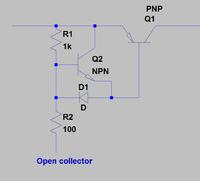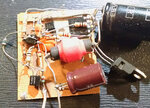R
red_alert
Guest
I was experimenting a BJT buck converter using a SG3525 in a pretty uncommon configuration (PWM pulses through the VC terminal, outputs connected to the ground).
The schematic diagram is as follow:

The input voltage is 24V, the output voltage is 12V, the intended load current is 10A and the switching frequency is 25kHz. The BJT is a high power/high frequency PNP transistor.
Overall, the circuit actually works.. but as the output current increases over 1-2A, the BJT is getting really hot.
I checked the waveforms for the base signal and the rise/fall times are quite big. As the rise time could be shortened by a higher base current (I'm going to put another BJT in a darlington configuration), I have no clue on how to speed up the turn off process.
Looking at the diagram, the only path for removing the saturation charge is the B-E resistor (R1). That's because the SG3525 output (VC) is an open collector and it's actually floating in off state.
I even tried a schottky diode across base and collector to limit the reverse C-B diode polarisation (saturation mode) to a smaller value (schottky forward voltage) thus the BJT it's not going into a deep saturation.
Neverthless, the waveforms wasn't changed too much and the heat is still present.
I'm thinking of an additional circuit - to put a small BJT across the B-E of the main (power) BJT and force it into the saturation mode when the PWM signal is floating.
Does anyone have any other ideas on how to deal with this situation?
The schematic diagram is as follow:

The input voltage is 24V, the output voltage is 12V, the intended load current is 10A and the switching frequency is 25kHz. The BJT is a high power/high frequency PNP transistor.
Overall, the circuit actually works.. but as the output current increases over 1-2A, the BJT is getting really hot.
I checked the waveforms for the base signal and the rise/fall times are quite big. As the rise time could be shortened by a higher base current (I'm going to put another BJT in a darlington configuration), I have no clue on how to speed up the turn off process.
Looking at the diagram, the only path for removing the saturation charge is the B-E resistor (R1). That's because the SG3525 output (VC) is an open collector and it's actually floating in off state.
I even tried a schottky diode across base and collector to limit the reverse C-B diode polarisation (saturation mode) to a smaller value (schottky forward voltage) thus the BJT it's not going into a deep saturation.
Neverthless, the waveforms wasn't changed too much and the heat is still present.
I'm thinking of an additional circuit - to put a small BJT across the B-E of the main (power) BJT and force it into the saturation mode when the PWM signal is floating.
Does anyone have any other ideas on how to deal with this situation?




